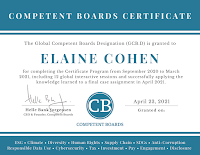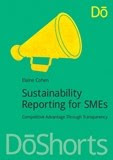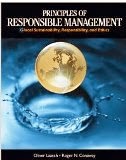What are sustainability material issues? GRI says "Material Aspects are those that reflect the organization’s
significant economic, environmental and social impacts; or
that substantively influence the assessments and decisions of
stakeholders."
Author's note: For those who haven't yet got it, Aspects (capital A) is the GRI word for material issues, as distinct from topics, which are non GRI-listed material issues, as distinct from aspects (lower-case a) which are looks, appearances or positions.
Where does innovation fit into all of this? Can innovation be described as a sustainability material issue?
According to GRI, in the GRI G4 Implementation Manual, innovation is not listed as a material Aspect. In fact, in 266 pages of Implementation Manual, the word "innovation" appears only once. Isn't that surprising? Most companies would say that innovation is their life-blood, and that it's impossible to deliver sustainable growth without innovation. Many innovations today have far-reaching consequences for society and the environment. Some are totally transformative. Think of digital revolution, hi-tech, bio-tech and everything-tech, low carbon society, advances in medicine and more. Forbes lists the most innovative companies in the world and Fast Company does exactly the same thing (same idea, different companies). Many of the most innovative companies are also the most sustainable, according other ratings and rankings.
There are 10 types of innovation, as I learned from a neat presentation I found on Slideshare. This presentation even provides an example of innovation for sustainability from FedEx, demonstrating the close connection between both:
In the great report produced by Fronesys a while back, innovation ranked 14 out of 140 separate material issues analyzed from the materiality matrices of 31 reporting companies. There is even an Institute for Sustainability and Innovation in Melbourne Australia.
So how come innovation is not a material issue Aspect in the GRI G4 framework?
I guess that this comes back to one of the core challenges we find in using the G4 framework.
At one level, G4 is refreshingly non-prescriptive, enabling companies to make a free choice of which issues to report, provided the company demonstrates some degree of process in selecting those issues.
At another level, any attempt to force-fit issues into a limited set of 6 Categories and 46 Aspects (and then select appropriate performance indicators) requires some mental acrobatics in order to adapt the G4 framework to the specific materiality messages of each company. Practically, having worked on several G4 reports so far (watch this space for publications this month :)) and having completed several G4-Ready analyses, I can say that this is one of the most difficult implementation steps of G4. And yet it is a critical step which governs the content of most of the G4 report.
In G4's view of the world, everything appears to be framed in terms of impact. What is innovation if not a way to make an impact? Innovation, then, is a product, or a service or a new organizational process. It's the product or service or process that makes the impact, not the innovation itself or the innovation process. Therefore, in GRI terms, the material Aspect is about the product or service. Products and services fit neatly into the material Aspects framework. As it stands, innovation does not.
This means that the G4 framework doesn't quite take into account the fact that innovation itself is a process and often seen as an issue in its own right. Innovation has a significant internal impact on the way people work, on organizational culture and on the sort of people you can hire and whether they stay. The G4 approach doesn't quite take into account that innovation is sometimes a multi-year process which may continue beyond the lifespan of a single sustainability report before it results in something that actually makes an external impact on society or the environment. In this case, investment in innovation and the innovation process may be equally as important as the product of innovation, as without this process, a company may not have a sustainable future.
Disregarding innovation as a material issue Aspect may also not take into account the fact that a company's customers, and possibly shareholders, expect innovation. For them, the fact that a company innovates is possibly one of the most critical sustainability issues on their agenda. Innovation may "substantively influence" the decisions of stakeholders. The consequences of innovation, especially in branded products, may not always be net positive. Consider obsolescence. Consider consumerism. Consider brawls on Black Friday. Consider workers in China committing suicide. Consider effects on employment demographics through changes in technology. Innovation is a critical element of any company's sustainability impacts, both internal and external, both positive and negative, and therefore might merit a more prominent place in a company's material reporting.
At present, if you define innovation as material for your business and/or your stakeholders, the only option you have in G4 is to force-fit innovation into an existing Category / Aspect.
 |
| GRI Implementation Manual Table of Aspects |
Maybe innovation is part of the Economic Performance material aspect? The G4 performance indicators that support this Aspect include economic value generated, climate change risks, benefit plan obligations and financial assistance received from governments. None of these are indicators of innovation process or products.
Maybe innovation is part of the Indirect Economic Impacts material Aspect? Here the performance indicators relate to infrastructure investments, and in G4-EC8, "significant identified positive and negative indirect economic impacts the organization has". This includes a range of possible examples from changing the productivity of organizations or society, to enhancing skills and knowledge, to the economic impact of the use of products and services. The output of innovation may bring some of these indirect economic impacts... but if the ability of a company to innovate is material, rather than the outcome of innovation, then this indicator would also be less relevant.
There does not appear to be another material Aspect in G4 which is a good home for innovation. Maybe innovation is in every process and should be part of the Disclosure on Management Approach for every single aspect reported. Innovation in the approach to Energy, Emissions, Supplier Assessment for Labor Practices etc? That might result in a rather disjointed report about innovation, with half sentences here and there throughout the report, and no strategic treatment of innovation as a way of doing business which is integral and critical for sustainable success.
The option in G4, therefore, one of the non-prescriptive features, is to create your own materialAspect topic.
Author's note: A material topic is a material issue which is not one of the pre-defined material Aspects in G4. If you do-it-yourself, you call it a topic, not an Aspect.
Let's say a company, known as a leader in innovation, 3M, were to create a material topic in its next G4 report and call it Innovation. In doing so, 3M would have to create performance indicators relevant to this topic. The 3M 2013 Sustainability Report gives us an example of how this might look. 3M has a New Product Vitality Index (NPVI) which measures the percentage of net sales of products introduced within the last five years as compared to total net sales.
Starbucks, one of Forbes' most innovative companies, looks at innovation in another way. the external impact of encouraging an innovative approach in the community.
The outcome of the above different examples of innovation practice may be both internal and external in terms of their impacts on the company and impacts on society. For each, a company would need to define this Aspect or topic Boundary in order to be in accordance with G4.
Therefore, in reporting with the G4 framework, you can see that there is enough flexibility to create a report around what is most material for your company, whether you apply the ready-made materiality content or create your own. I guess that means applying innovation to the use of the G4 framework. HaHa. See, it's working already. The key thing is to decide what's really critical for the sustainability of your business and your stakeholders, and apply the relevant approaches and measures consistently, and report them transparently.
A similar force-fit problem/opportunity applies to several other company sustainability issues. I have a list :). I'll come back to this now and again here on the CSR Reporting Blog, your global resource for CSR and Sustainability reporting info, insights, fun, headaches and references to ice-cream.
There does not appear to be another material Aspect in G4 which is a good home for innovation. Maybe innovation is in every process and should be part of the Disclosure on Management Approach for every single aspect reported. Innovation in the approach to Energy, Emissions, Supplier Assessment for Labor Practices etc? That might result in a rather disjointed report about innovation, with half sentences here and there throughout the report, and no strategic treatment of innovation as a way of doing business which is integral and critical for sustainable success.
The option in G4, therefore, one of the non-prescriptive features, is to create your own material
Author's note: A material topic is a material issue which is not one of the pre-defined material Aspects in G4. If you do-it-yourself, you call it a topic, not an Aspect.
Let's say a company, known as a leader in innovation, 3M, were to create a material topic in its next G4 report and call it Innovation. In doing so, 3M would have to create performance indicators relevant to this topic. The 3M 2013 Sustainability Report gives us an example of how this might look. 3M has a New Product Vitality Index (NPVI) which measures the percentage of net sales of products introduced within the last five years as compared to total net sales.
Starbucks, one of Forbes' most innovative companies, looks at innovation in another way. the external impact of encouraging an innovative approach in the community.
Cisco's 2013 CSR Report has a performance indicator for the number of employees engaged in innovation. Innovation is part of the Cisco culture and it is measured, among other things, by the number of employees who confirm they are encouraged to find new ways of doing things.
Therefore, in reporting with the G4 framework, you can see that there is enough flexibility to create a report around what is most material for your company, whether you apply the ready-made materiality content or create your own. I guess that means applying innovation to the use of the G4 framework. HaHa. See, it's working already. The key thing is to decide what's really critical for the sustainability of your business and your stakeholders, and apply the relevant approaches and measures consistently, and report them transparently.
A similar force-fit problem/opportunity applies to several other company sustainability issues. I have a list :). I'll come back to this now and again here on the CSR Reporting Blog, your global resource for CSR and Sustainability reporting info, insights, fun, headaches and references to ice-cream.
elaine cohen, CSR consultant, winning (CRRA'12) Sustainability Reporter, HR Professional, Ice Cream Addict. Author of Understanding G4: the Concise guide to Next Generation Sustainability Reporting AND Sustainability Reporting for SMEs: Competitive Advantage Through Transparency AND CSR for HR: A necessary partnership for advancing responsible business practices . Contact me via www.twitter.com/elainecohen or via my business website www.b-yond.biz (Beyond Business Ltd, an inspired CSR consulting and Sustainability Reporting firm)

























1 comment:
I really like what you say about reporting with the G4 gives flexibility to create a report around what is most material for your company. Truly that´s what Im doing with my clients.
Regards and thanks for give us your opinion on this very importan topic of GRI G4.
Post a Comment